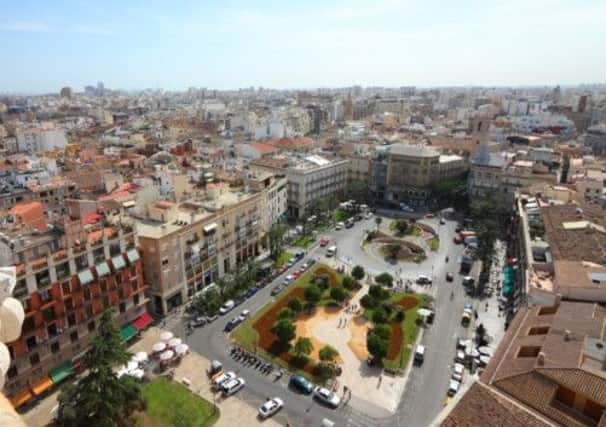Travel: A tour with the Borgias is to die for


THE Borgias. A family never noted as warm and wonderful human beings. Bribery, corruption and nepotism, not to mention murder, rape and incest, were all part of the mix for these consummate politicians who were prepared to do anything to get and retain power, and they were for a time in the Catholic church, uncontainable.
With a TV series and books exploring their life and times stoking interest, it seemed a good time to go to Spain to see where their story began. We started in Xativa, a prosperous city in the Valencia region, with a castle towering over the old streets. We walked past the solid townhouse where Rodrigo was born, where he grew up looking onto the unchanged plaza and fountain, explored the church where he was christened, and found not just the Borgias, but many aspects of old and new Spain.
Advertisement
Hide AdWe were in good company, for our guides were Patrick and Julia Waller of The Spanish Thyme Traveller, he English and she Spanish. Patrick was employed in the food industry in both England and Spain, and also has contacts with beer and wine producers, so although our tour was loosely based on the Borgias, it included much of his expertise. Julia was our introduction to Mediterranean life and because there were just five of us in our people carrier – although larger groups travel in a small executive coach – we could all interact and endlessly quiz the Wallers about Spain now and then.
But back to the Borgias, and Pope Calixtus III, an elderly Spanish cardinal who the Italians appointed as a sop to those who objected to an entirely Italian succession, reasoning he wouldn’t last long. He didn’t; a mere three years, but what they hadn’t expected was his nephew Rodrigo, abbot of the monastery of Santa Maria de Valldigna, a gloriously baroque edifice where we started our tour. The monastery is set in the most beautiful and peaceful gardens, just outside Valencia, and as always in Spanish history it has been the subject of changing fortunes. Well funded in its heyday, it was latterly a farm store, and housed soldiers during the Spanish Civil war, before being restored when its value as part of Valencian history was recognised. For Rodrigo Borgia it was a stepping stone to becoming a cardinal as he intrigued and manoeuvred to such effect that he became Pope Alexander VI.
We had other professional guides with us as well as the Wallers, and during our day in Xativa we learned of the city’s prosperous past when it was a hub for various industries such as silk weaving and paper making. I drank from Xativa’s famous Trinity fountain which the Borgias must also have used, the waters of which promise what all ancient fountains promise; long life, prosperity, happiness, maybe even becoming Pope. Later I discovered that the magic only works if you drink from each of the 25 spouts. Ah well.
Visits that proved to be highlights of this lush, green region were a walk through vineyards, and seeing cellars with 3,000-litre amphoras dating back hundreds of years, then tasting Cullerot wine with Manchego cheese and almonds at a table under the almond trees of the orchard. Also of interest were: a bullring carved out of stone; caves dating from the 10th century said to have been lived in by Moriscos (expelled Moors after the Christian reconquest of Spain) in the 16th century; and a visit to the bodega of Heretat de Taverners, a small winery where the sweet red Punt Dolc was a revelation, as were the craft beers in a wine shop in Xativa, where we learnt that gin and tonic is the party drink in Spain.
Not that it was all drinks – there were also hearty lunches with the Wallers in different restaurants, with tapas, and paella, the traditional lunchtime dish of Valencia, and two charming Relais de Silence hotels. One of these, the Station hotel in Bocairent, was the quietest hotel ever.
Stand-out occasions were a lunch at a rural house where paella Valenciana was prepared over the flames of an open fire and we sat on a covered terrace looking out over the countryside. And, a mountain top, Les Alcusses at Moixent, with the remains of an Ibero village from 500BC that had been abandoned in a hurry, probably after an attack 100 years after being built. From these heights we could see three different regions and appreciate what a wonderful look-out position it was. The guide here, Jose Maria, really made history sing, showing us the village street and dwellings, the guards’ stations at the gates, and in a restored home a pre-Christian approach to security, a huge wooden five lever action lock and key.
Advertisement
Hide AdThen to Valencia, and back to the grandeur of the Borgias. The city has many great sights; the cathedral, the house of silk – a commodity exchange and a World Heritage monument with graceful arched ceilings where you can picture the bustle of the merchants of the Borgia era as they went about their business – an art deco rail station, many modern museums and a great food market.
There is also the Palace of the Borgias, now the headquarters of the Valencian Parliament, and a reminder that the Borgias, dreadful as they were, were also contributors to the arts and the glories of the Renaissance.
Factfile
Advertisement
Hide AdThe Spanish Thyme Traveller - thespanishthymetraveller.com - offers various cultural tours. The five-day Borgia tour includes B&B accommodation, four lunches, two evening meals and all transport, for £1,095 per person. Flights from London Gatwick to Valencia with easyJet, from £159 return (easyjet.com)
• The Borgias, Sky Atlantic HD on Mondays, 9pm; The Borgias: The Hidden History, G J Meyer, Random House, £19.70; Blood and Beauty, Sarah Dunant, Virago, £10.87